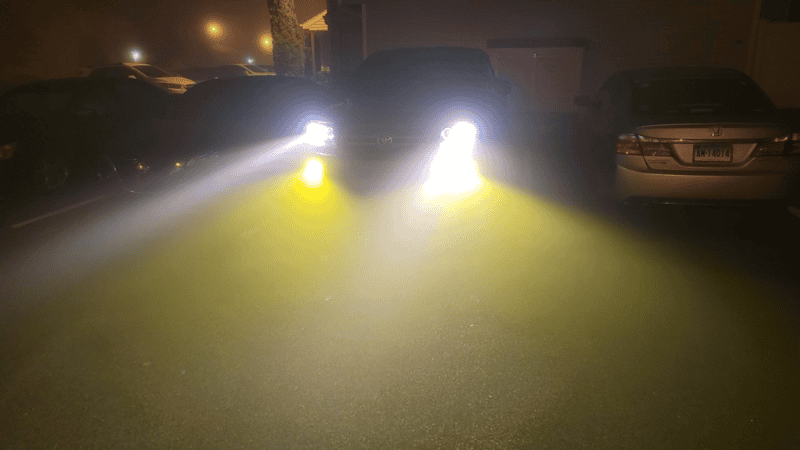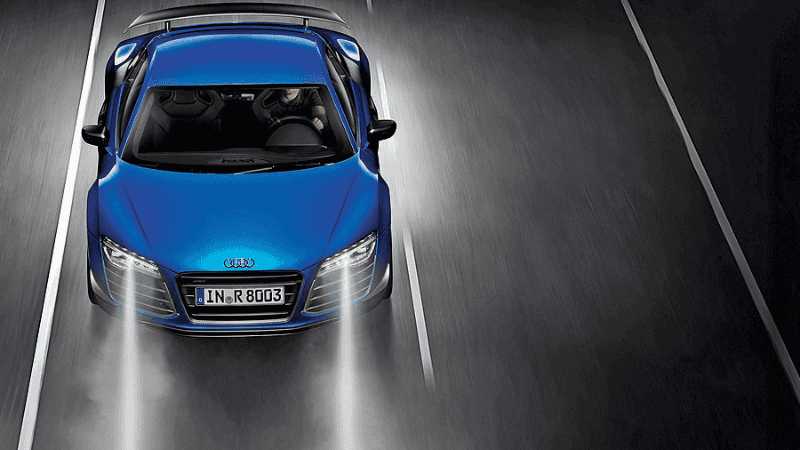Do you know which one is better, fog lights or high beams, in different situations? In this guide, you’ll learn which one you should choose between fog lights and high beams.
Many drivers struggle to understand the correct use of fog lights and high beams. With our comprehensive expertise in car light manufacturing, we can help you make the safest choice while driving.
Ready to explore the differences between fog lights and high beams? Let’s dive into it.
Fog Lights vs High Beams: Why They Matter for Safe Driving
Fog lights and high beams are two types of vehicle lights that improve visibility in different situations. Here is how they work:
What Are Fog Lights and Why Are They Essential in Bad Weather?

Fog lights are car lights that help improve visibility during challenging weather conditions, such as dense fog, heavy rain, dust storms, or snow. They produce a sharp, wide, and low cut-off light that remains close to the road surface. It limits the amount of light that reflects off moisture in the air, preventing glare and vision impairment for other drivers.
These lights create short-range beams that illuminate only a limited area in front of the vehicle. They are positioned below the headlight unit on the vehicle’s bumper. It aids in limiting reflection and offering optimal road illumination.
Not all cars have fog lights. Inspect your vehicle or consult the manufacturer’s manual to learn if you have them. Some vehicles also come with rear fog lights. They emit red light to alert the oncoming traffic.
How High Beams Work and When to Use Them Safely

High-beam lights are an integral component of your vehicle’s lighting system. They are meant to offer better illumination for nighttime driving in unlit stretches. They emit bright and focused light beams that project far into the distance. These lights are present within the headlight assembly. They offer significantly more brightness than low beams.
High beams provide long-range visibility, illuminating a broader area of the road ahead. They provide additional visibility to spot potential obstacles from a distance.
The extended field of vision offers you sufficient reaction time and improves your safety. You can activate high beams by pushing or pulling the turn signal arm, making them accessible to you.
However, you should use high beams responsibly to avoid glare and discomfort for other road users. The intense beams of these lights can temporarily blind oncoming drivers.
It can lead to dangerous situations, increasing the risks of accidents. Therefore, it’s best to switch them off in well-lit urban areas.
When to Use Fog Lights vs High Beams for Maximum Safety
Understanding the usage of fog lights and high beams is crucial for safe driving. Here’s a closer look at when you should use fog lights and high beams:

Foggy Conditions
Fog lights are crucial for driving during foggy, rainy, or snowy conditions when the visibility is limited. Unlike headlights, these lights are manufactured to emit wide and flat light beams that stay low on the road. This feature limits the amount of light reflected by dense fog, rain, or snow particles. It reduces glare and assists you in maintaining a clear view.
Fog lights, being mounted low on the vehicle, illuminate the area of the road below the fog line. It helps you locate lane markings, road edges, and potential obstacles on the road. Effective use of fog lights allows you to safely navigate challenging weather conditions.
In contrast to fog lights, high beams are not suitable for foggy conditions. Their intense, far-reaching beam reflects off fog particles. It makes it difficult for you to see the road.
Dark Roads

High-beam headlights are the best ally while traveling on open roads with little or no light. These lights are engineered to project light to an extended area on the road. It illuminates the road ahead, enabling you to spot obstacles and challenging curves from a distance.
The extended visibility range is crucial while driving at high speed, as it enables you to react quickly to hazards. However, you need to be cautious when using high beams.
These lights cause considerable glare and discomfort to the oncoming drivers. It’s best to use it when an oncoming drive is 500m away from you. Switch to low-beam headlights when you observe a driver within the 500m range.
Low-Beam Alternative

Low beams are the best for driving in low-visibility conditions. However, if your low beams are not working, you should switch to fog lights. Unlike low beams, fog lights emit shorter and wider light beams. It makes them effective for driving during fog or storms.
This beam pattern prevents light from scattering back toward your eyes. It makes it easier to maintain clarity in poor weather conditions.
Although fog lights offer a limited visibility range, their broader coverage can make the surroundings visible. You can also use fog lights alongside low beams in adverse situations. They maximize visibility without creating excessive glare.
Fog Lights vs High Beams: The Key Differences Explained
Fog lights and high beams differ in several ways, making each suitable for specific driving conditions. Here are some key differences between the two types of car lights:
| Aspects | Fog Lights | High Beams |
|---|---|---|
| Beam Pattern and Light Distribution | Low, sharp, and wide beam pattern | Intense and narrow beam |
| Mounting Position | Lower on the bumper | Higher on the bumper |
| Law Requirement | Not necessary in clear weather. | Use them when oncoming drivers are 500m or 200m away |
Beam Pattern

Fog lights produce a broad, flat beam of light that focuses on illuminating the area directly in front of your vehicle.
They are mounted a few inches above the ground to limit the light from reflecting from the airborne particles. By keeping the light close to the surface, fog lights help reduce glare. It makes them effective in low visibility and poor weather conditions.
In contrast, high beams offer a more intense and narrower beam pattern. The light beams are more focused and illuminate an extensive area ahead.
These are directed higher than fog lights, enabling you to illuminate a larger portion of the road. However, these lights lead to significant glare for other road users.
Mounting Position

Fog lights are positioned lower on your car, closer to the ground. They are integrated into the bumper, below the headlight housing. In contrast, high beams are positioned higher on your vehicle. They are present within the headlight unit.
Legal Requirements
Many states have stringent regulations concerning the use of fog lights. The United Nations Economic Commission for Europe (UNECE) mentions that the front fog lights should have a yellow or bright white light. Many regions have regulations that prohibit the use of fog lamps under normal conditions.
The regulations governing the use of high beams differ across states. The Code of Virginia prohibits the use of these lights when the oncoming traffic is within a 500m range. Some countries limit this range to 200m.
Safe Driving Guidelines for Fog Lights and High Beams
You have to follow some guidelines while using fog lights and high beams. Here are some general guidelines for these lights:
Guidelines for Fog Lights

- Use fog lights only in foggy, rainy, or snowy conditions. RAC mentions that you should use fog lights only when visibility falls below 100m.
- Avoid using fog lights in normal circumstances. Don’t turn them on when you are not encountering thick fog or snowfall.
- You can use fog lights as a low-beam alternative in poor visibility conditions.
Guidelines for High Beams

- Employ high-beam headlights on dark roads with minimal or no ambient lighting to illuminate the road.
- Avoid using them when approaching oncoming traffic to prevent glare.
Fog Lights vs High Beams: Pros and Cons You Must Know
The advantages and disadvantages of fog lights and high beams are given below:
Benefits of Fog Lights

- Fog lights improve visibility in harsh weather by casting a low, wide beam of light. The light being close to the ground allows you to see the road clearly.
- The low position of light beams limits the light reflection back towards you. It reduces glare, offering safe visibility.
- The wider light beam provides you with a broader view of the road. It boosts your overall visibility without overwhelming your sight.
Advantages of High Beams

- High beams emit a long-range light that illuminates farther down the road compared to low beams. It makes it convenient for you to detect obstacles, road signs, or animals at a distance.
- These lights provide ample illumination on highways, in rural areas, and in areas with no light. It allows you to navigate safely and anticipate changes in the road ahead.
- The extended visibility offers you sufficient time to react to obstacles or potential hazards. Timely action can reduce the likelihood of accidents.
Drawbacks of Incorrect Use of Fog Lights

- Improper usage of fog lights can cause glare for other drivers. Using them inaccurately in clear weather can worsen the situation.
- Using fog lights in good lighting conditions results in the scattering of light. It makes it daunting to focus on the road.
- Fog lights consume considerable energy. Their unnecessary usage can drain the vehicle’s battery faster.
- Many regions have laws that regulate the usage of these lights. Using them in high-visibility conditions can lead to fines or penalties.
Disadvantages of Incorrect Use of High Beams

- Inaccurate use of high beams can lead to intense glare for oncoming road users. These lights can temporarily blind them, leading to accidents.
- Using them in poor weather, such as rain, fog, and storms, can reflect a large portion of light. It reduces your visibility instead of improving it.
- Frequent and unnecessary use of high beams consumes more energy. It drains the battery faster, especially in less efficient vehicles.
Conclusion

Knowing when to use fog lights and high beams makes driving at night or in bad weather a lot safer. Fog lights help you cut through fog, rain, and snow, while high beams light up dark roads when visibility is low.
Using them the right way not only keeps you safe but also avoids blinding other drivers.
Upgrade Your Lighting Today – Get Free Samples & Expert Support
Have you found durable fog lights and high beams for your vehicle? Having efficient and reliable car lights is crucial to ensure optimal performance. However, not all manufacturers offer high-end lights.
Carligtvision is a prominent name in the vehicle lighting industry. We manufacture innovative and high-quality car lights with advanced technology. Our products offer superior performance. Explore them and contact us for inquiries and free samples.
Fog Lights vs High Beams FAQs (Answered by Experts)
Q1: Can You Use Both Fog Lights and High Beams Together?
Yes, you can employ fog lights and high beams together. However, it’s not recommended. Using high-beam headlights in foggy conditions can lead to glare. It makes driving conditions unsafe for you and other road users.
Q2: Do All Cars Have Fog Lights?
No, not all cars come with fog lights. They are more commonly found in newer or higher-end models. Some vehicles only offer them as an optional feature.
Q3: Can Fog Lights Replace Headlights?
No, fog lights are not a substitute for low or high beams. They can supplement low-beam headlights and are only useful in low-visibility conditions.
Q4: What Are Other Types of Auxiliary Lights?
Other auxiliary lights include daytime running lights (DRLs), spotlights, strip lights, and light bars. These lights serve different purposes. DRLs improve daytime visibility. Spotlights provide focused beams for long-distance illumination. Strip lights are often used for decorative or accent lighting. Light bars offer broad, powerful lighting for off-road or work-related applications.




